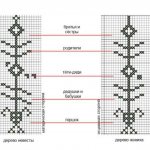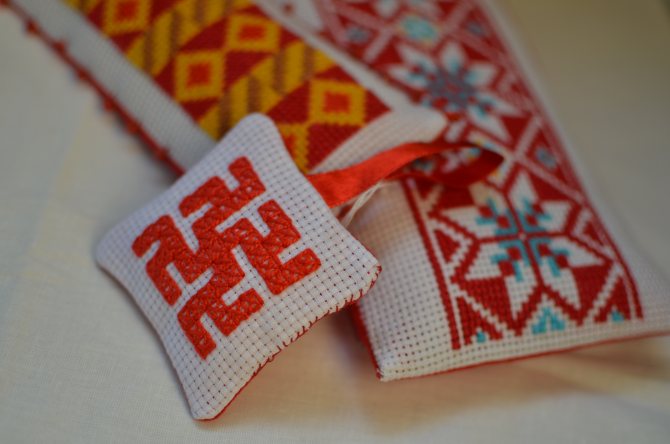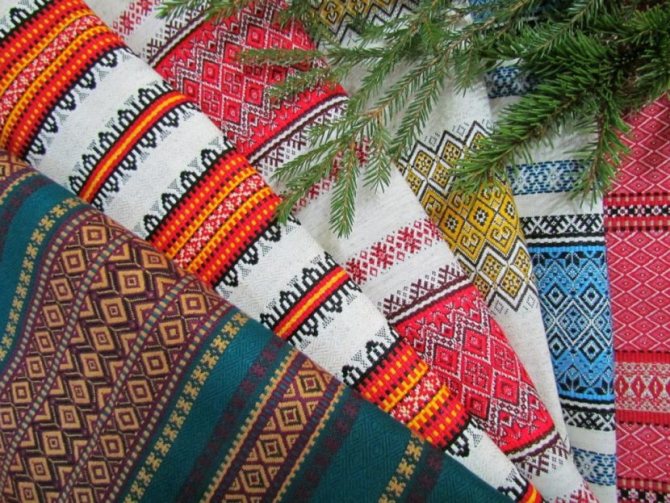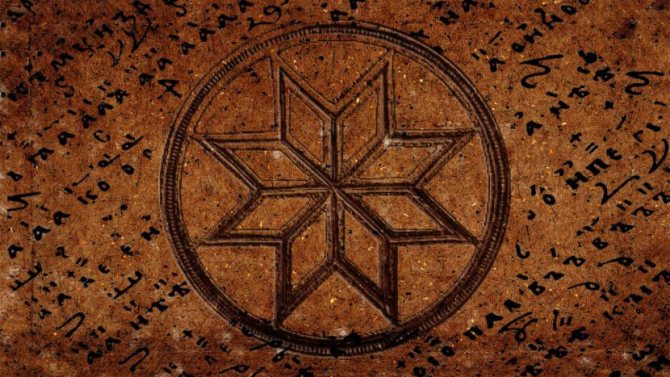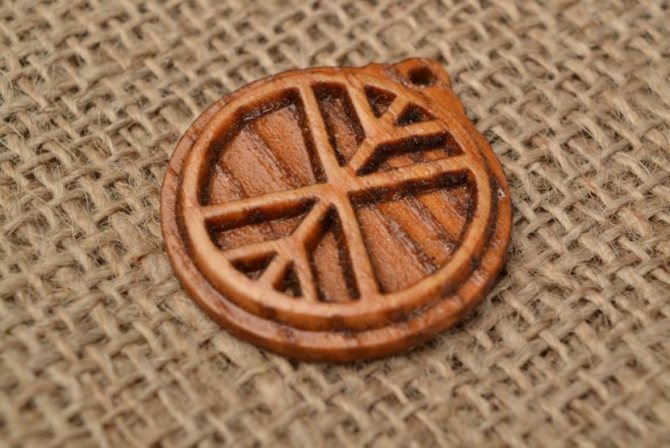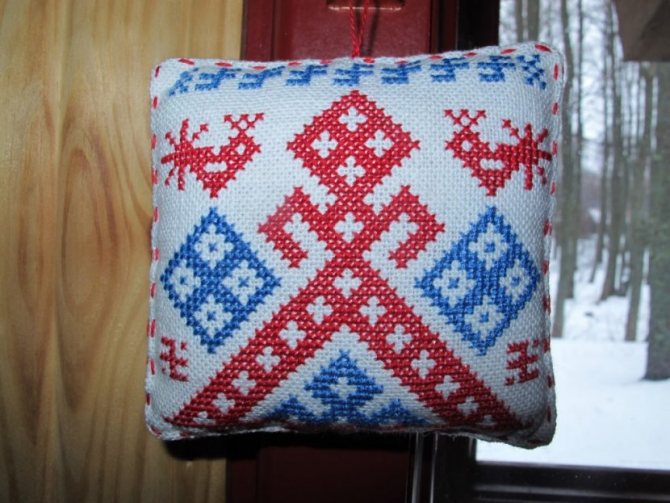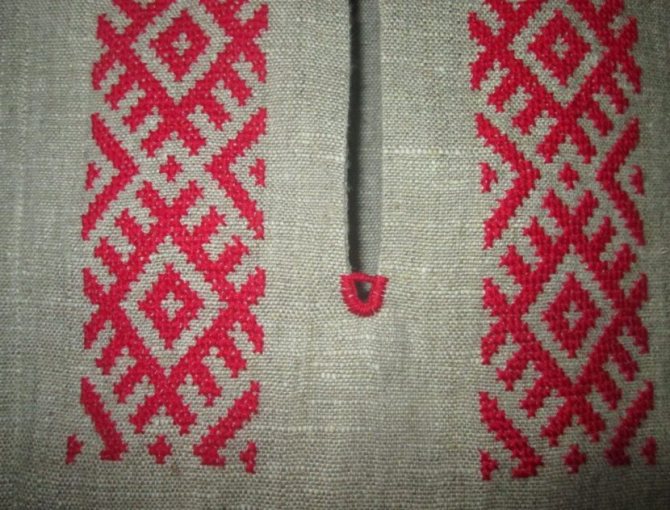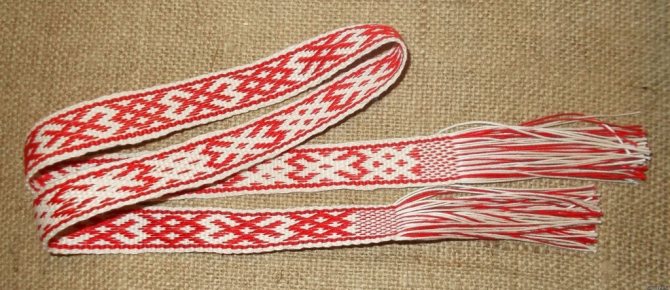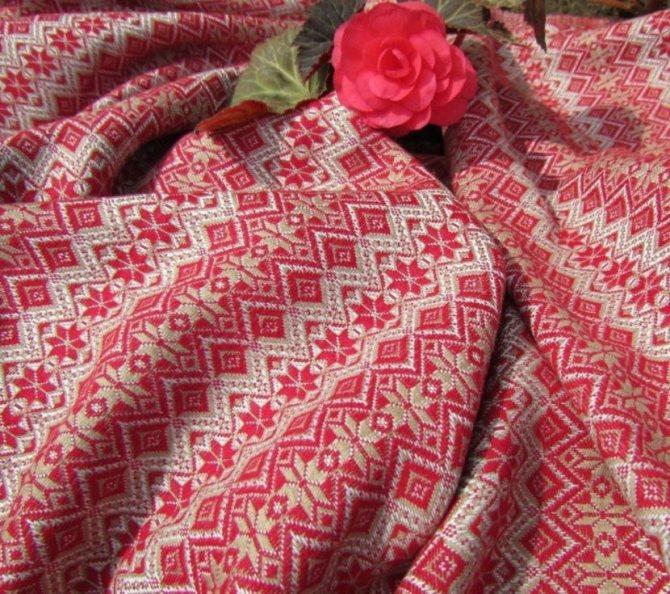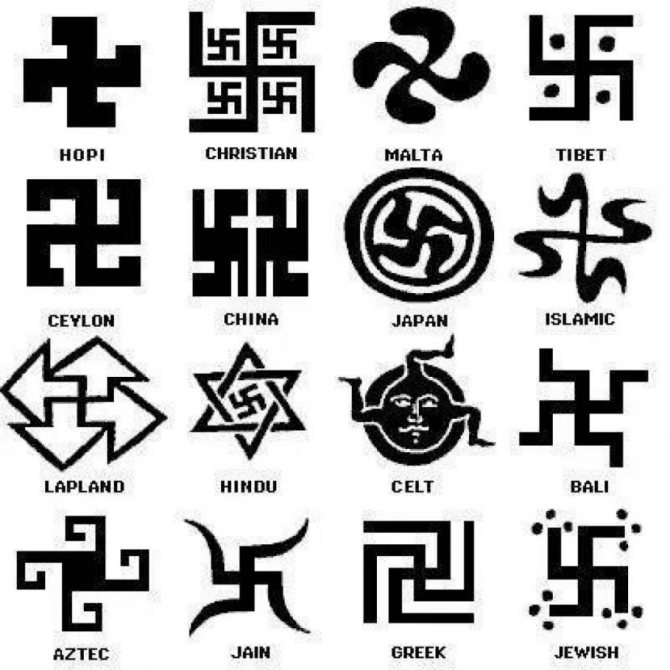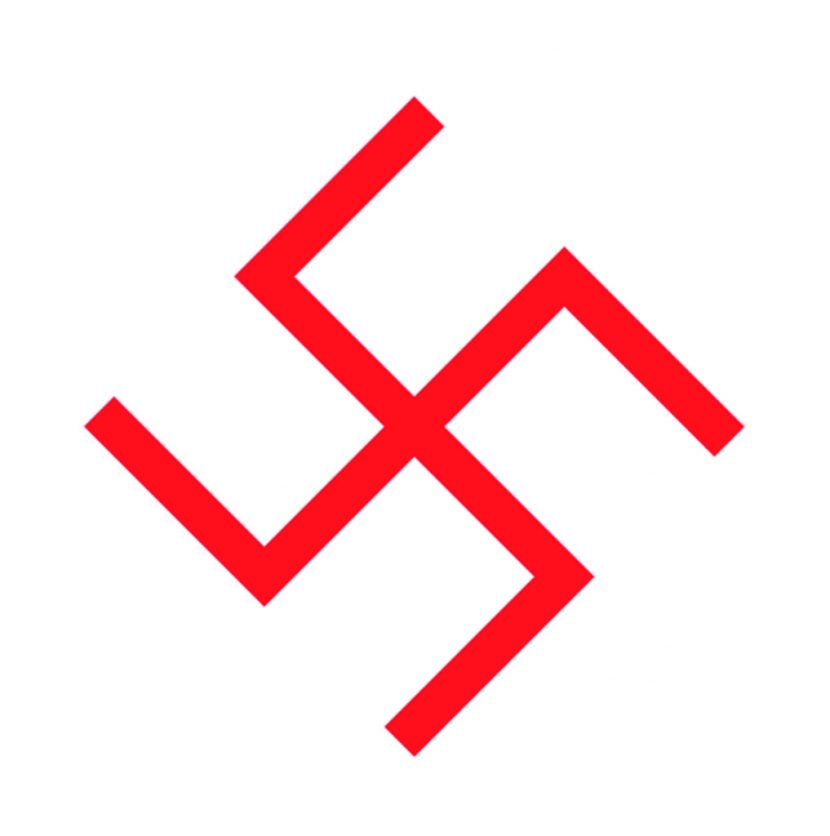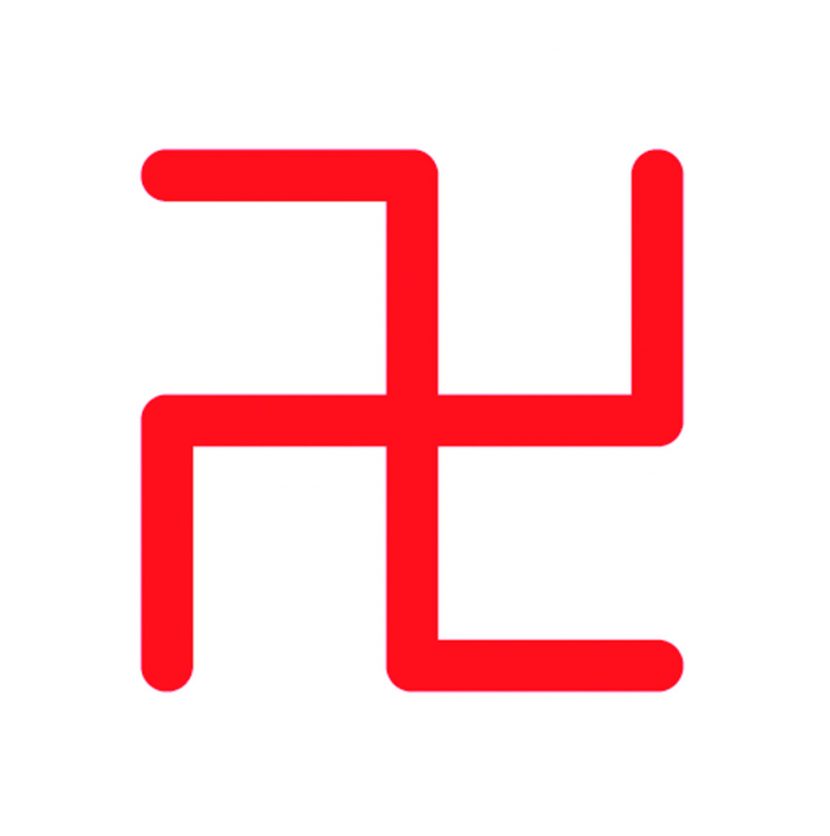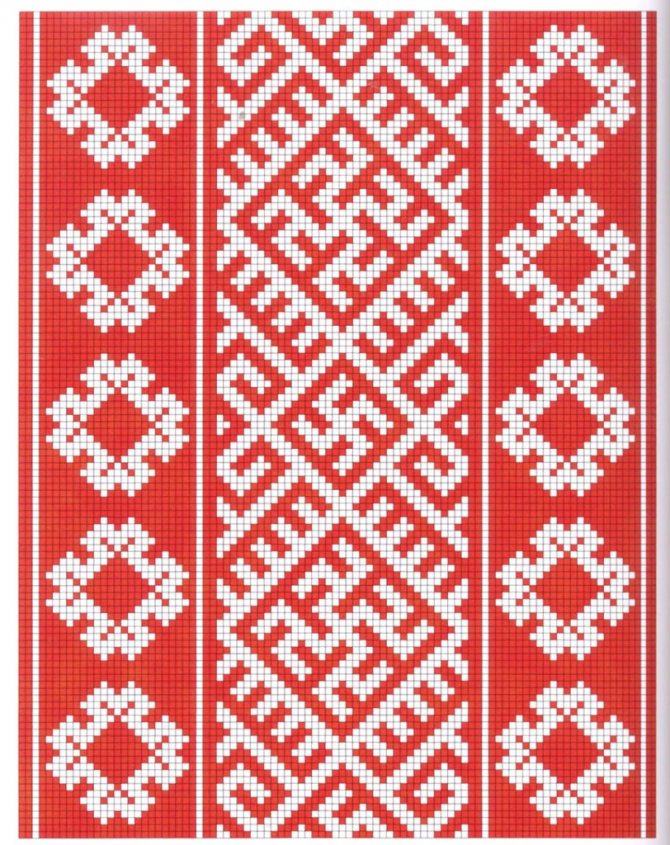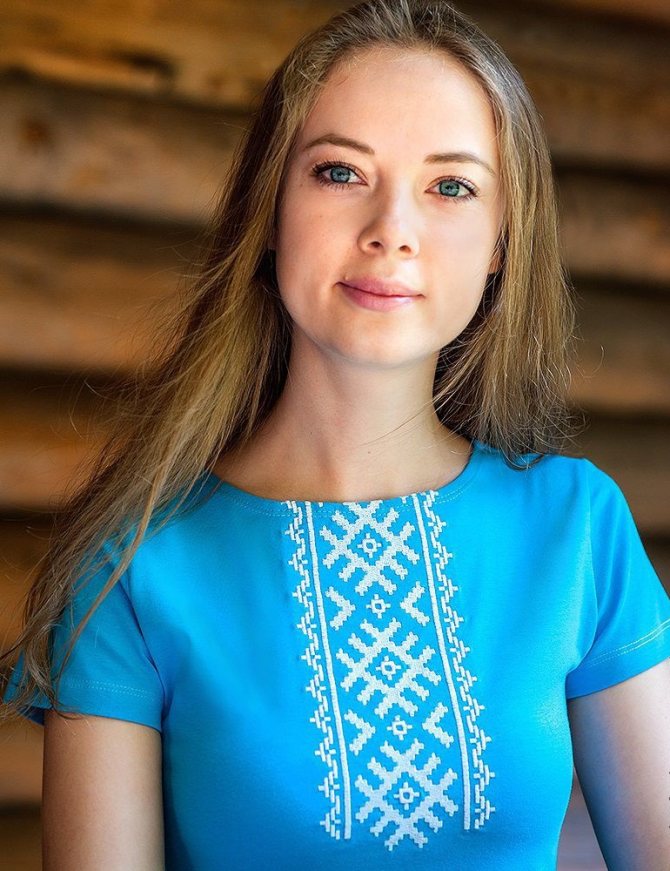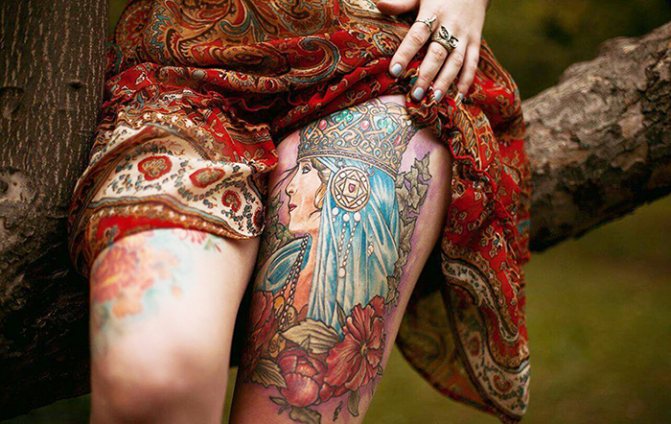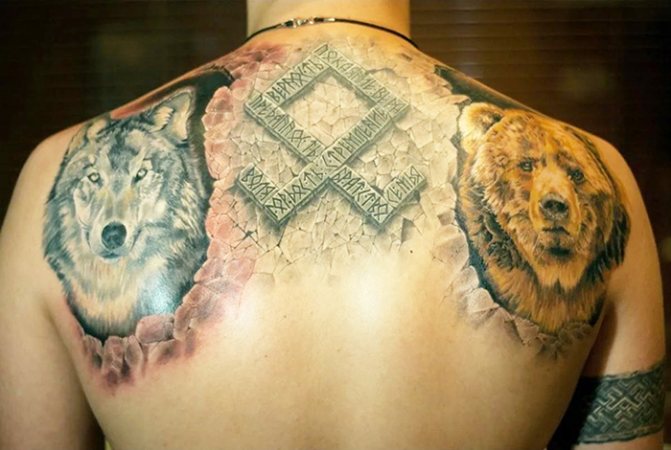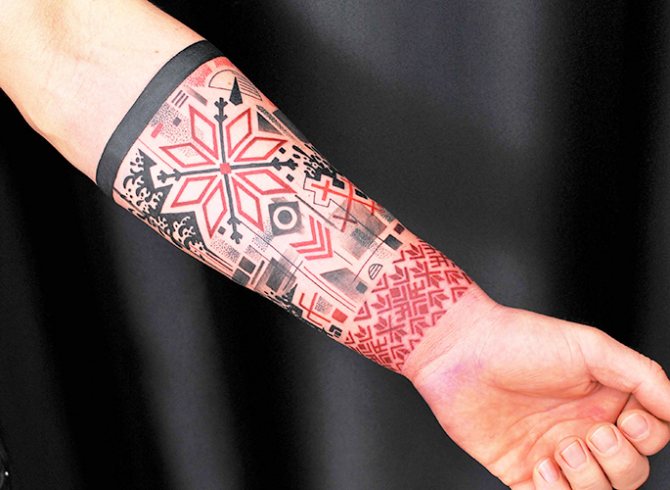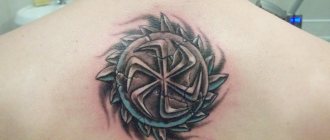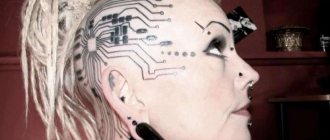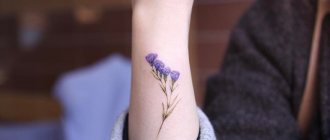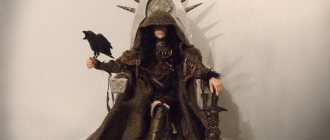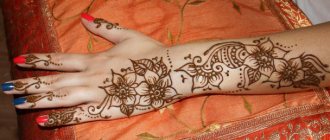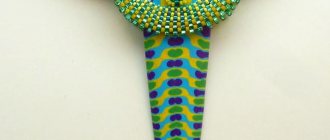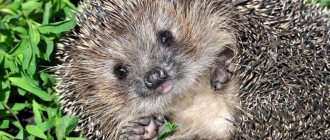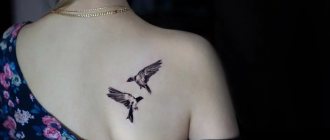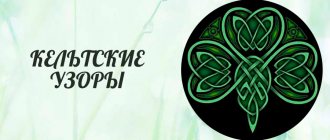Pattern is something that we can see. What do you see in a pattern? You understand that just a quick glance is enough and it's clear that it's not just a chaotic collection of squiggles and crosses. It's a language, a code. How do you read it, understand it?
Nowadays it is fashionable to say all sorts of incomprehensible words, even to scientists, like meditation. Our ancestors simply saw the whole Universe in the Patterns. Does this Universe open to you?
An excellent example of the use of Slavic patterns is folk embroidery. Patterned embroidery was used to decorate towels, wedding trims, tablecloths, curtains, holiday shirts, white linen sundresses, light outerwear, hats and scarves.
Example: towel is a symbolic and meaningful product. It not only decorates everyday life, but is a symbolic reminder of the invisible ties that connect each person with his family, ancestors, and is an art object. One can say that the patterns of embroidered towels is a coded narrative about the life of the people, nature and people.
towel
It is believed that embroidery decorated those parts of the costume, through which, according to our ancestors, evil forces could penetrate to the human body. Hence the main meaning of embroidery in antiquity was protective. The collar, cuffs, hem, neckline were embroidered with protective pattern. The fabric itself was considered impervious to evil spirits, as it was made of items abundantly equipped with a spell ornament. Therefore, it was important to protect those places where the cloth of the garment ended and the human body began. But most importantlyThe pattern on a garment said a lot about the owner himself. The pattern on clothes as a talisman is not its main purpose. A personal shirt is closer to the body because it is like a skin, only yours, for you and about you.
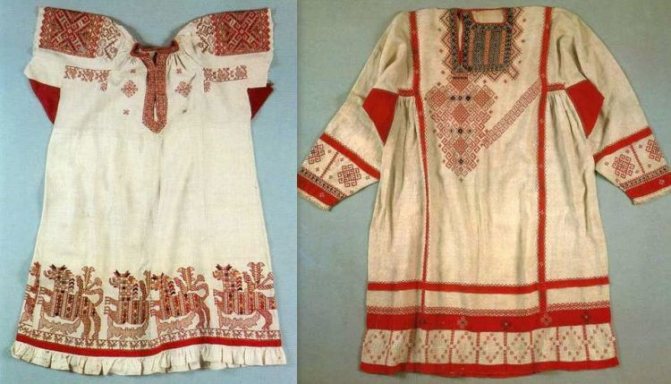
Clothing was like a unique picture of its owner and carried a rich semantic load. Not only by the cut of clothes but first of all by the pattern one could understand where the person was from, who he was, what was his occupation, what was his spiritual status and perception of the world, etc. The protective function of the pattern was taken for granted. To give an example, if a child holds hands with his father, the father will of course protect his child in case of danger, but it has nothing to do with where they go and what they talk about on the way.
Children's clothes were usually made of parents' old clothes - not only and not so much because it washed many times and therefore soft, it would not hurt or hurt a child's skin, and because it absorbed parental energy and strength and with it protected and kept a child from evil eye, spoilage and misfortune. Clothes were sewed from the mother's clothes for a girl and for a boy - from the father's, of course, thus determining the correct development depending on the sex - the girl received maternal power, and for a boy - masculine power.
When the children grew up and had already acquired some protective power of their own, they were given their first shirtfrom the novena. This was usually timed to coincide with the first initiation at the age of three. From the age of twelve a girl got the right to wear her own (for the time being a maiden's shirt, though), a boy was entitled to his first noble clothes. was entitled to his first pants-porters.
As children under three years of age often wore clothes remade from their parents' clothes, the talismanic embroidery on them remained the same, of course, parental. It was not only inconvenient and impractical to change it, but also inexpedient because in addition to its protective function it provided the connection of generations, kinship and continuity. If a child's father was a hunter, the protective articles on his clothes were connected with hunting, and they were handed over to the boy through the clothes. In the same way in the female line a craft was "passed on" to the girl. Or rather, it was not the craft itself but the strength of many years of parental experience in it that protected the child. Everyone protects in their own way, right? Weaver will protect with a special pattern of cloth, spinner - with a nauzami, hunter - with a fang of an animal ... But the result will be the same.
But amulet embroidery for a child's own clothes was already different from amulets of adults. First, the color of amulet embroidery for children was always red, while for adult clothing it could be different. For example, women often used black, the color of mother earth, in addition to red, in their embroidery, thus trying to protect their wombs from infertility. Men, on the other hand, often needed blue or green as a talisman - blue protected against death by the elements, green against wounds. Children did not have this. Children were considered to be were under the care and protection of their kind. On the girl's shirt there was embroidery on the hem, sleeves and necklaces, but on a married woman - on the chest, collar, the embroidery on the hem was wider - it also reflected a new kinship, belonging to the family of her husband.
The main protective symbols for a girl were: the Goddess Protectress of Destiny, the symbol of the familyThe women's symbols of the earth (again, different from the women's symbols of the earth - in those it was mostly represented as either ploughed or already sown) and women's crafts.
Boys (as well as girls) up to the age of twelve wore shirts without belts. The main symbols guarding boys were considered to be: symbols of fire, solar symbols, images of totem animals, of course also the symbol of the patron clan and patron spirits of the day of birth, bells-bells and symbols of men's crafts.
Until adulthood, boys and girls could also wear common amulets. Passing the initiation at the age of twelve, the boy's amulets changed, becoming (just like the girl's) more gender-specific. There was a belt and, of course, there were fewer amulets - because his own power was growing.
In the embroidery already appeared images of the Gods, not so much for protection, but for patronage, young girls - symbols of fertility, young boys - warrior symbols. Of course, neither a girl nor a boy needed them. In addition to embroidery on clothing, there were often many items of child amulets, which were hung over the cradle of the baby, a boy or a girl's bed, and then carried on the shoulder or belt. All this performed not only a protective and protective function, but also served as a link between man and nature.
Patterns .
Often ancient craftsmen depicted signs that indicated the sun. These are solar signs. Over the millennia, the sun has received a great many variations of depiction. These include a variety of crosses - both in a circle and without it. Some crosses in a circle are very similar to the image of the wheel, and this is for a reason: man saw the sun moving, that is "rolling" across the sky, like a fiery wheel. The eternal movement of the celestial luminary was marked by a hooked cross, a swastika. The swastika denoted not only the moving sun, but also a wish for prosperity. It is especially common in northern embroidery, both in towels and shirts, and in bran weaving.
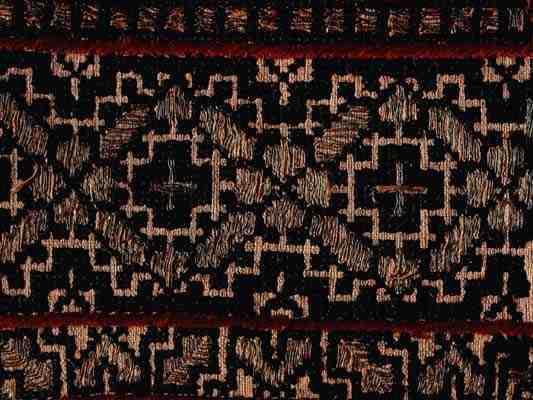

Wedding shawl. Detail of the embroidery. First half of the 19th c. Tambov Province. Shatsky uyezd. Double-sided sewing and ironing.
Features
Slavic images of ancient gods, rune alphabet, patterns and ornaments have clear lines of application, harmony and proportionality of the figure, the presence of additional volume and shadows. When choosing a tattoo on ancient Russian themes, it is important to find a professional tattoo master who can take into account all the nuances of the Slavic style.
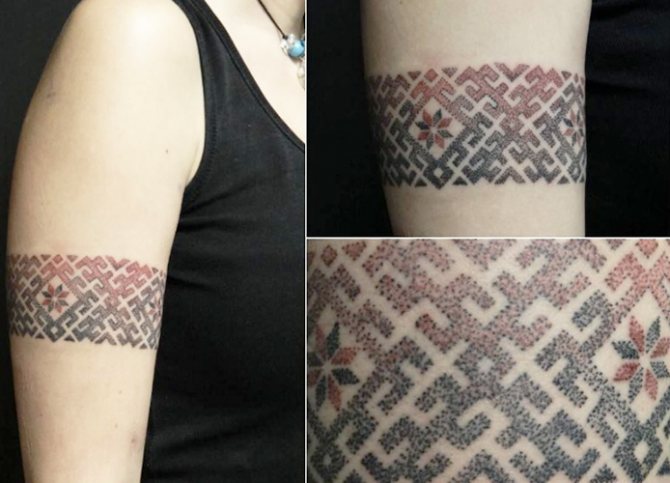

It is equally important to know the meaning of the applied symbols, because the Slavic runes are difficult to apply and it is very easy to make a mistake, which will completely change the intended meaning of the pattern.
Awe-inspiring patterns
The essence of amulets exactly corresponds to their name: their mission is to protect people, especially in the years of hard times, during military conflicts and other adversities. In other words, to protect their owner from any directed negative influence, no matter what it was and where it came from. Negative influences may be purely physical - such as diseases (caused, by the way, often not only by natural causes, but also overcome us as a result of the evil eye or spoilage). Amulets can protect their owners from any influences on their psyche, soul and emotional sphere. They will protect you from imposing of another's will, spells, compulsions from the outside and from severe depression.
The effect of amulets is connected with the colors of the spectrum of the human aura. Putting on amulet of appropriate color, we get an opportunity to quickly patch up energy breakdowns in this or that part of aura, which can be dangerous for our health and even life. From the point of view of a person who can see the aura, it will look like a strengthening of luminescence of a certain color of aura when wearing amulet.
The origin of the Slavic tattoos
Slavic tattoo designs and patterns were never applied to the body for beauty. The Slavs had certain images that only men or women were allowed to wear, and there were also specially designed for young children. The ancient Slavs firmly believed that any image on the human body could change one's destiny, give strength in battle, heal from disease, help in conception, protect from spoilage and the evil eye or improve one's social status.
Therefore, tattoos were treated very carefully, only wise men had the right to apply them. Most often, the process of applying the image to the body was accompanied by a certain ritual, enhancing the impact of the tattoo on the person.
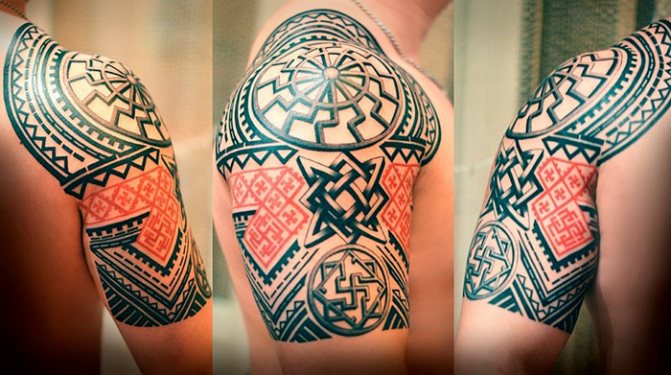

Since the advent of Christianity in Russia, Slavic symbols were banned as remnants of pagan worship. Over time, the sacred meanings of Slavic tattoos have been forgotten and therefore, it is now difficult to find an accurate depiction of the old Slavic symbols. Most often stylized images with distinctive Slavic motifs and colors are used, most often used in ancient Russian embroidery.
Signs
- The wavy line is a sign of the Water. Rain is depicted by vertical lines, rivers, underground waters - by horizontal ones, "obstacles of heaven" - by horizontal ones.
- The Thunderbird (a six-pointed cross in a circle or hexagon). Sign of Thunder (and Perun). Used as a talisman against lightning, is also a military amulet.
- A square (or rhombus) divided by a cross into four parts - (ploughed field). If there are dots inside - a sown field. These are the signs of the Earth and fertility.
- Colocress (a cross within a circle). Sign of the Sun. an obstacle and aversion of evil, a sign of closeness.
- Krada ("lattice") is a sign of Fire. Krada - a sacrificial or funeral pyre.
- Kres (equilateral cross: straight or oblique) - sign of Fire (and the God of Fire - Aguni).
- Month - Sign of the moon, the month. Known pendants "lunnitsa".
- Cock's comb with seven projections - sign of Fire.
- Horn of plenty. Sign of wealth, abundance.
- Jarga (swastika). Otherwise - a whirligig. There are a huge number of variants of drawing. Yarga - sign of the Sun (and, respectively, the Sun Gods: Khors, Dazhdbog, etc.). According to the direction of rotation (solar / counter-solar) distinguish the sign of a bright sun (sun of Yavia) and the sign of the dark sun (sun of Navi). The Sun of Yavia is a beneficial, creative Force; the Sun of Navi is a destructive Force. According to Slavic myths, after sunset the Sun illuminated the Underground (Navi), hence the name. We know that the Sun is not under the Earth at night, but it is difficult to doubt the existence of the destructive aspect of the Sun... There are two interpretations of the direction of rotation of the sign; traditional, as far as I know, is as follows: the ends of the rays bend against the direction of rotation.
- A tree (most often a herringbone) is a symbol of the interconnectedness of everything in the world, a symbol of long life.
- The spiral is a symbol of wisdom; if the color scheme is blue-violet, it is a symbol of innermost knowledge. A powerful repellent sign for all the dark entities of the shadow world - if the color is red, white or black.
- A triangle is a symbol of man; especially if accompanied by small dots or circles on the side of the top. A symbol of human communication.
A little more about symbols.
To understand all the beauty of the Slavic averting symbols is possible if you study their meanings. Observing the patterned embroidery, looking at the intricate intertwining of ornaments, the eye loses focus, and the picture becomes "holographic. Attention switches between dark and light signs. Where the dark is all earthly, and the light is the heavenly world.
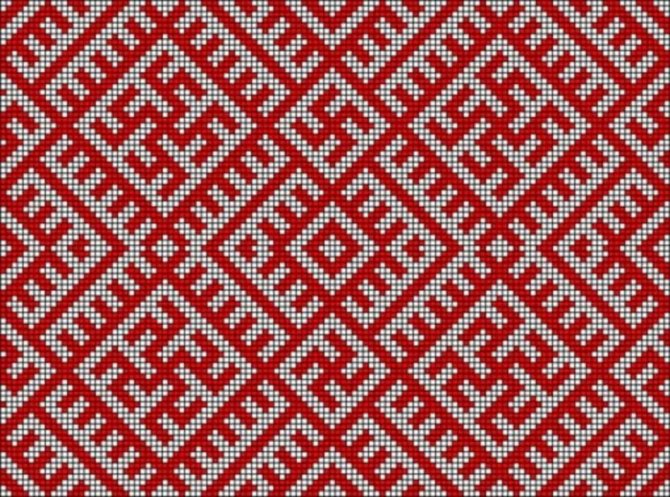

Wanting to decipher the meaning of the inherent in the patterns, you must take into account that, depending on the location of averting symbols on the clothing changes its interpretation. The Slavs accepted a three-part division of the world: Yav, Nav and the world, where a place is given to man. Accordingly: the neck and shoulders are the highest divine light, the hem is the Underworld, the sleeves are the middle human world.
By placing one sign in different worlds, it acquired different meanings as well. Male and female, light and darkness, earth and sky, top and bottom - such opposites eventually lead to the process of movement, development is continuous and eternal.
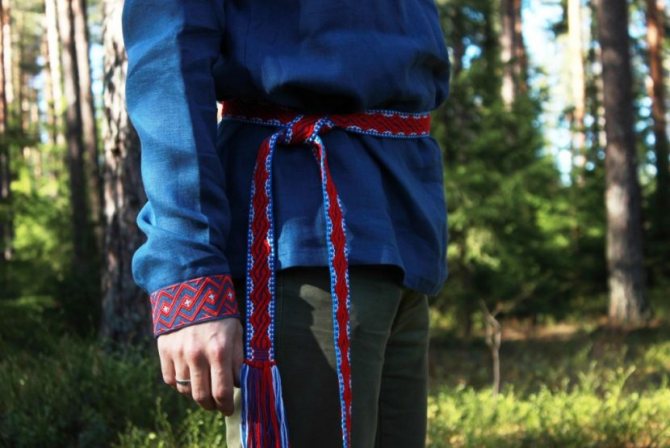

The ancient Slavs had to observe the golden mean, to keep in balance the two sides of power. Symbols were created and perfected over the centuries, they absorbed special sacred meanings, magic and works of their ancestors. These are strong protective amulets, so their beauty and aesthetics should be judged in the last place. For a very long time, masters have honored the canons, according to which the ornament was embroidered, they were aware of the meaning. But to the beginning of XX century many things were lost.
Modern embroiderers can no longer explain what they embroidered, but somewhere in the remote reaches of the ancient patterns still live and delight their fans. There are still people who consciously wear amulets, delving into and comprehending the mysteries of the past.
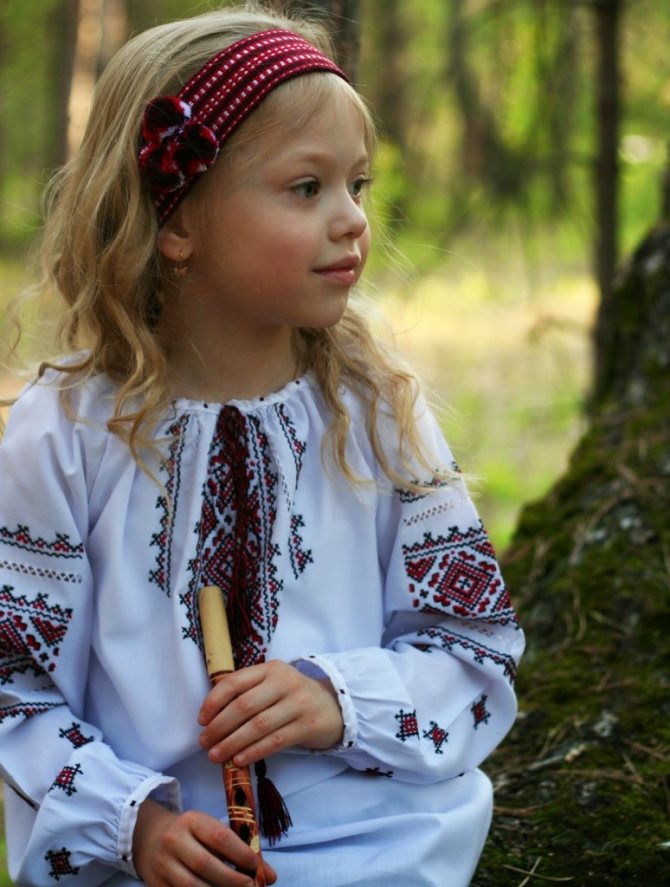

Slavic costume has always been admired by overseas merchants. Clothes skillfully emphasized the external and spiritual beauty. The rhythm of geometric details plays an important role. To know the truth, to feel harmony and magnificence is possible through creativity. Nevertheless, one should not run to look at the mysterious ornament. It requires a special mood, a spiritual attitude, when one hears one's heart and is ready to follow its call.
Gods
Woman with raised palms: Makosh. With lowered: Lada.
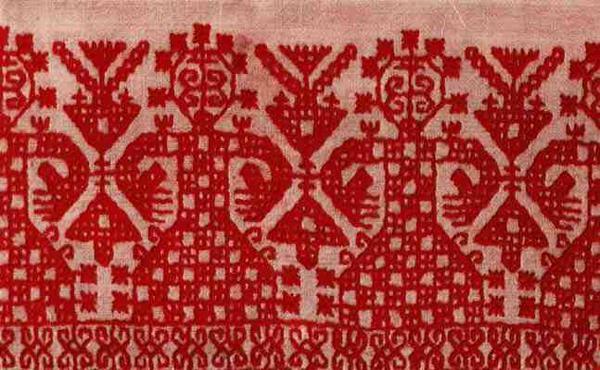

Towel. Embroidery detail. The end of the 19th century. Novgorod Province, Ustyuzhna District. Double-sided sewing.
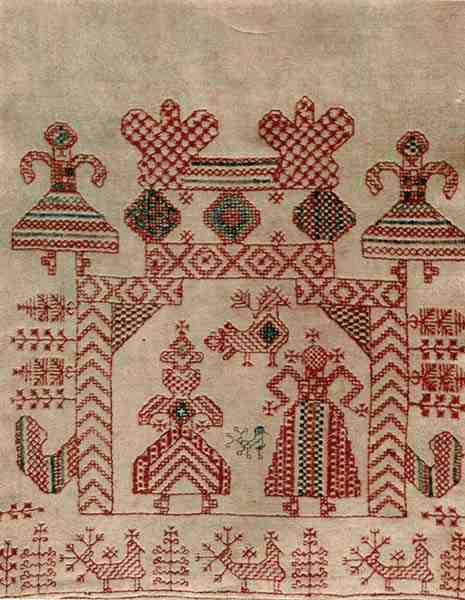

The end of the towel. The second half of the 19th c. Olonets Province, Kargopolsky uyezd. Double sided and double sided sewing.
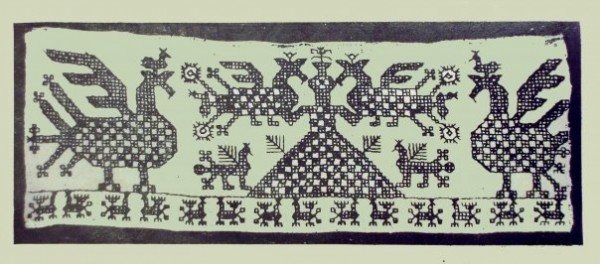

Makosh .
This image is revealed from an unusual side in the article "Ivan. Kupal etymology".
Animals
- The bull is a sign of Veles.
- The wolf is a sign of Yarila.
- The raven is the sign of wisdom and death.
- Tree - sign of life and fertility; or - of the Universe (World Tree).
- Serpent - the sign of the earth, wisdom. Associated with the Lower World.
- Horse - the sign of the Sun, the Solar Gods.
- Swan is the sign of Mara, death, winter.
- Bear is the sign of Veles.
- A stag (female) or a moose is a sign of the Goddesses of Fertility (the Horns).
- An eagle is the sign of Thunder, Perun.
- A rooster is a sign of Fire, Aguni.
- Falcon - the sign of Fire, Agun. There is an opinion that the "trident" (coat of arms of the Rurikovich and modern Ukraine) is a stylized image of a falcon in flight.


Towel. Detail of the embroidery. The end of the 19th - beginning of the 20th cc. Pskov Province, Porkhov uyezd. Sewing with a tambour.
Colors
Specifically the colors of the amulet are associated with the protection of one of the seven human chakras. Red - for the lowest one, located in the coccyx area and responsible for the genitourinary system, rectum, musculoskeletal system. Orange - for the second chakra, located a few fingers below the navel, which is responsible for sexual energy and kidneys. Yellow is for the third chakra (solar plexus area), the center of vital energy, which is also responsible for all abdominal organs. Green is for the fourth, heart chakra. It controls not only the heart, but also the lungs, spine, hands, and is responsible for our emotions. Blue is for the fifth, the throat, responsible for the respiratory and hearing organs, the throat and skin, as well as human creativity. Blue is for the sixth (third eye area), responsible for our intellectual abilities. Violet is for the seventh (the "head"), which connects us to the Higher Powers, to God.
- White. Associated with the idea of Light, purity and sanctity (White Light, White King - over kings, etc.); at the same time it is the color of Death, mourning.
- Red - Fire, (and Sun - as the heavenly Fire), blood (life Force).
- Green is Vegetation, Life.
- Black - Earth.
- Gold - Sun.
- Blue indicates Sky, Water.
- Purple is rarely seen in Russian embroidery.
